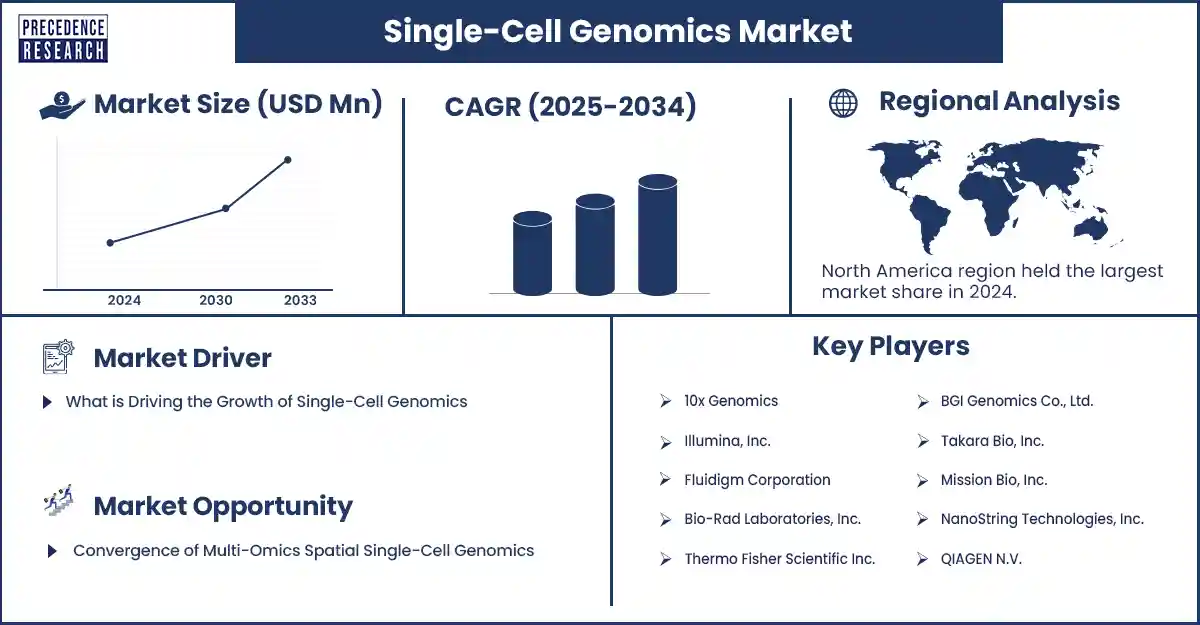Single-Cell Genomics Market Revenue and Forecast by 2033
Single-Cell Genomics Market Revenue and Trends 2025 to 2033
The global single cell genomics market reveal increasing demand for personalized medicine and advanced genomic solutions globally. The market growth is driven by the increasing need for personalized medicine, advancements in next-generation sequencing (NGS) and microfluidics, and growing applications in oncology, immunology, and developmental biology.

Single-Cell Genomics Market: Key Drivers & Emerging Opportunities
Single-cell genomics is a powerful technique that uses advanced next-generation sequencing technologies to analyze the genetic information from individual cells, providing insights into cellular heterogeneity and complex biological processes. The market is driven by the rising incidence of cancer and demand for precision medicine, fueling adoption, as the technology enables analysis of tumor heterogeneity and personalized therapies. Continual technological advancements in sequencing, microfluidics, and bioinformatics are enhancing efficiency and accessibility. Furthermore, significant investments in research and development and increased funding accelerate market expansion across academic and pharmaceutical sectors. Growing applications in drug discovery, for identifying novel targets and studying drug resistance, are also crucial drivers. Lastly, the increasing demand from stem cell research for developing new therapies further propels market growth.
Segment Insights
- By product & service, the consumables segment dominated the market because of the repeated demand for these essential components across experiments, including reagents, assays, and kits. These consumables are widely used in numerous processes like cell processing, isolation, and analysis.
- By technology, the single-cell RNA sequencing segment led the market due to its ability to reveal cellular heterogeneity vital for personalized medicine and cancer research, along with developments in technology that lower costs and increase accessibility.
- By workflow, the genomic sequencing segment held the largest share due to a significant rise in research and development funding, widespread adoption of genomic analysis products, and the technology's ability to provide comprehensive insights into genetic features.
- By application, the oncology segment represented market dominance due to the rising need for detailed insights into tumor heterogeneity, cancer progression, and treatment resistance.
- By end user, the academic & research institutes segment accounted for market dominance because of significant government and foundation-backed funding for foundational research and the development and validation of new technologies.
Regional Insights
North America led the single-cell genomics market due to robust government funding for research, widespread adoption of advanced technologies like NGS, a strong biopharmaceutical and biotechnology sector, a growing focus on personalized medicine, and supportive research infrastructure with key industry players and academic institutions. A strong shift towards personalized medicine, where treatments are tailored to individual genetic makeup, drives demand for single-cell genomics.
Asia Pacific is anticipated to be the fastest-growing region in the market due to significant investments in genomics and biotechnology, rising demand for precision medicine, large populations, increasing chronic diseases, and favorable government initiatives supporting research and infrastructure. Countries like China, India, Japan, and South Korea are emerging as innovation hubs, with increasing development and adoption of cutting-edge sequencing technologies.
Single-Cell Genomics Market Coverage
| Report Attribute | Key Statistics |
| Quantitative Units | Revenue in USD million/billion, Volume in units |
| Largest Market | North America |
| Base Year | 2024 |
| Regions Covered | North America, Europe, Asia-Pacific, Latin America, and Middle East & Africa |
Recent Development
- In October 2024, Parse Biosciences launched the Parse GigaLab™ to scale single-cell sequencing to billions of cells per year. The GigaLab leverages Parse’s Evercode™ single-cell technology with a scaled-up workflow and expanded automation for researchers focused on large-scale drug and perturbation screens, dataset generation for generative AI models, and atlasing for population studies. (Source: https://www.parsebiosciences.com)
Get this report to explore global market size, share, CAGR, and trends, featuring detailed segmental analysis and an insightful competitive landscape overview @ https://www.precedenceresearch.com/sample/6852
You can place an order or ask any questions, please feel free to contact at sales@precedenceresearch.com |+1 804 441 9344